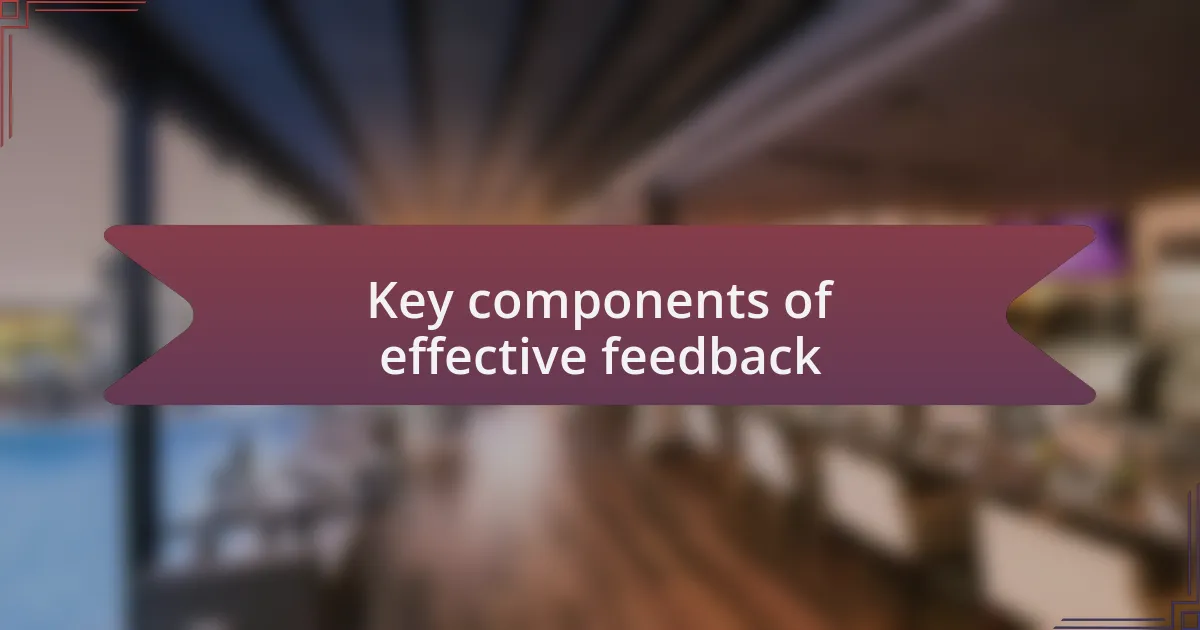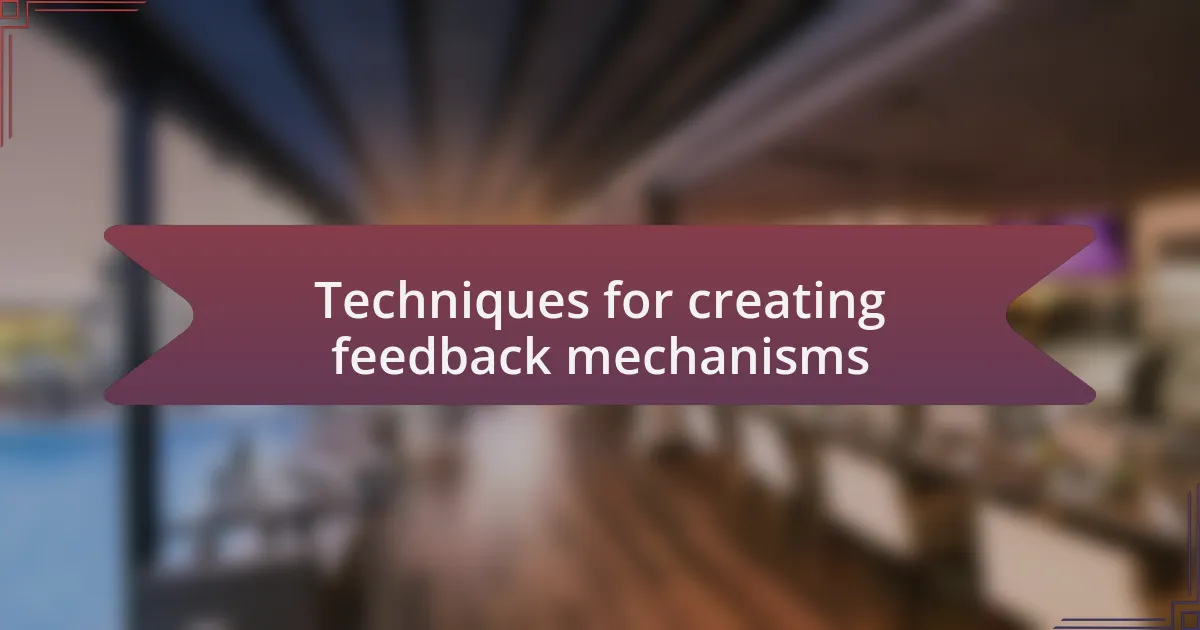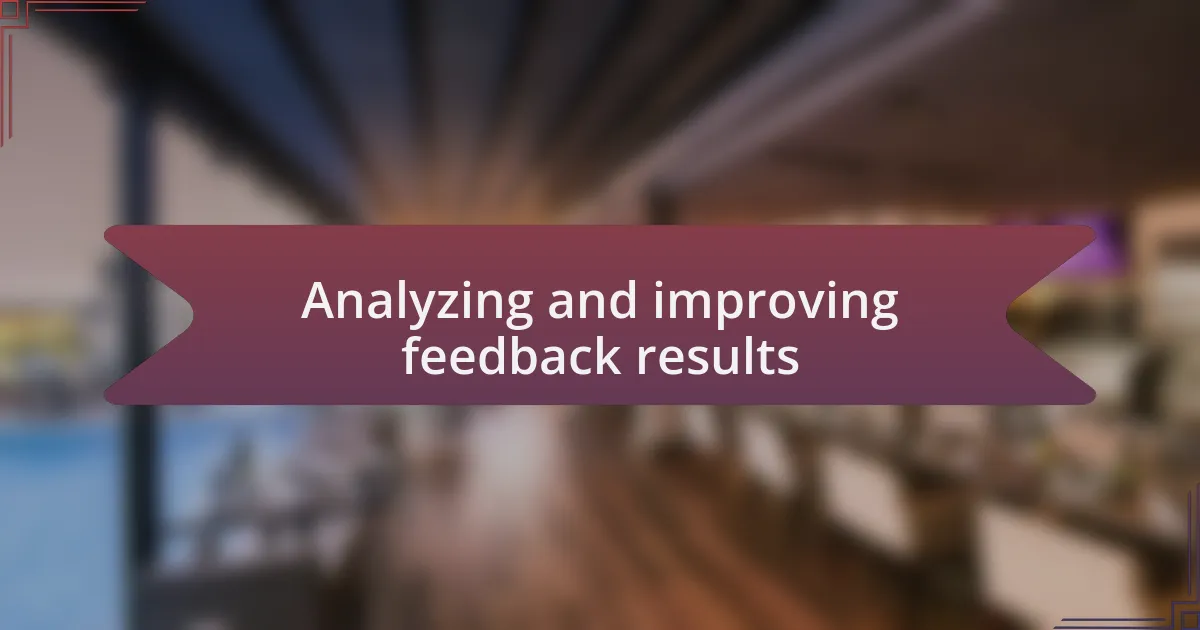Key takeaways:
- Effective feedback requires clarity, timely delivery, and a safe environment for open discussions.
- Implementing regular check-ins and using anonymous surveys can enhance communication and uncover genuine insights.
- Creating structured feedback sessions and leveraging real-time tools fosters a culture of continuous improvement and timely communication.
- Analyzing patterns in feedback and tracking the impact of changes are crucial for evolving processes and driving innovation.

Key components of effective feedback
One of the key components of effective feedback is clarity. When I first started receiving feedback on my code, I often felt overwhelmed by vague comments. Specificity can transform a confusing critique into actionable insights. Isn’t it frustrating when you’re told something is wrong, but not given concrete guidance on how to fix it?
Another crucial element is timing. I’ve noticed that feedback delivered shortly after an event tends to be more impactful. For example, when my team conducted code reviews right after implementing a feature, it felt fresh and relevant, allowing us to quickly identify areas for improvement. Have you ever found that waiting too long for feedback can leave you feeling disconnected from your work?
Lastly, fostering a safe environment plays a pivotal role. I once worked in a team where feedback sessions felt like a battleground. It wasn’t until we prioritized openness and respect that genuine discussions flourished. When feedback feels safe, don’t you think it encourages more honest and constructive conversations?

Techniques for creating feedback mechanisms
Creating effective feedback mechanisms is essential for evolving as a software developer. One technique I found beneficial was implementing regular check-ins, which can be less formal than a full review. During one project, I introduced weekly touchpoints where team members shared their recent challenges and successes; this practice not only fostered trust but also allowed for real-time feedback that was relevant and actionable. Have you considered how a simple conversation could uncover hidden insights?
Another method I advocate for is using anonymous surveys. Early on in my career, I collected feedback on our team processes through a digital tool, and the candid responses I received were eye-opening. Many team members felt hesitant to speak up during meetings, but anonymity allowed them to voice their concerns and suggestions genuinely. Wouldn’t it be amazing if you could unlock that level of honesty within your own teams?
Utilizing collaborative tools can also enhance feedback loops significantly. I remember integrating a project management platform that included commenting features directly on tasks. This change empowered everyone to give and receive feedback in the context of the work being done. It felt like having a dialogue right there on the work itself, which made it easier to act on suggestions. Isn’t it incredible how the right tools can bridge communication gaps?

Best practices for gathering feedback
One of the best practices I’ve found is to create a structured feedback session after major milestones in a project. Reflecting on my own experience, we gathered the team after a sprint to discuss what went well and what could be improved. This not only formalized the feedback process but also built a culture of continuous improvement. Have you ever felt the power of collective insights after a successful phase?
I also encourage open dialogue during code reviews and design discussions. Personally, I learned the value of actively inviting diverse viewpoints when I led a peer-review session that showcased our differing approaches to the same problem. I saw how welcoming varied opinions enriched our work and, more importantly, fostered a supportive environment. Don’t you think that opening up conversations can lead to breakthrough ideas?
Lastly, leveraging real-time feedback tools, such as Slack or Microsoft Teams integrations, has transformed how I gather opinions instantly. I remember a time when a simple message helped identify a critical bug that could have gone unnoticed for a while. By enabling quick communication, I could address the issue promptly and keep the team aligned. Isn’t it fascinating how technology can drive timely discussions and decision-making?

My personal strategies for feedback
Embracing a culture of feedback starts with personal accountability, which I’ve found to be crucial in my approach. For instance, I make it a point to request feedback not just from my team but also from stakeholders on my own work. This has led me to discover blind spots I was unaware of, and honestly, it can be humbling. Have you ever felt the anxiety of awaiting feedback, only to be pleasantly surprised by the insights it brings?
One of my favorite strategies is to utilize feedback forms after client demos. I recall a project where we earned invaluable insights through a simple survey. Clients pointed out features that resonated well with them, which helped steer our next development cycles. I often ask myself, how can I elevate our service to meet and exceed client expectations? Engaging clients directly through their feedback feels like an empowering way to align our objectives.
Additionally, I find it powerful to follow up on feedback given. Sometimes, I call team members a few days later to discuss what they thought of the changes made based on their suggestions. This practice not only shows that I value their input but also opens a door for continuous dialogue. It’s amazing how this simple act can spark renewed enthusiasm and commitment from the team. Have you ever experimented with following up, and if so, what revelations did you uncover?

Analyzing and improving feedback results
One key aspect of analyzing feedback results is sifting through the responses to identify patterns and trends. For instance, during a recent project, I noticed that multiple team members mentioned a specific feature was causing confusion. This alerted me to a potential design flaw that might have gone unnoticed. Have you ever taken the time to look for common threads in feedback? It can be a game-changer, revealing areas for improvement that may not be immediately obvious.
Tracking the impact of implemented feedback is another vital step I take. After incorporating suggestions from a recent client discussion, I monitored how usage metrics shifted over the next few weeks. It was enlightening to see user engagement improve significantly. Have you ever realized the power of metrics in validating your changes? This direct connection between feedback and measurable outcomes not only boosts my confidence but also reinforces the importance of a feedback loop.
To truly improve feedback results, I often revisit the initial feedback system I established. I’ve learned that periodically refreshing the questions or methods of gathering input can yield new insights. For instance, after some time, we revamped our survey to focus not only on satisfaction but also on expected features. It was amazing to see how this tweak opened up conversations about innovation. How often do you reassess the effectiveness of your feedback tools? Regular evaluations can keep your approach relevant and impactful.